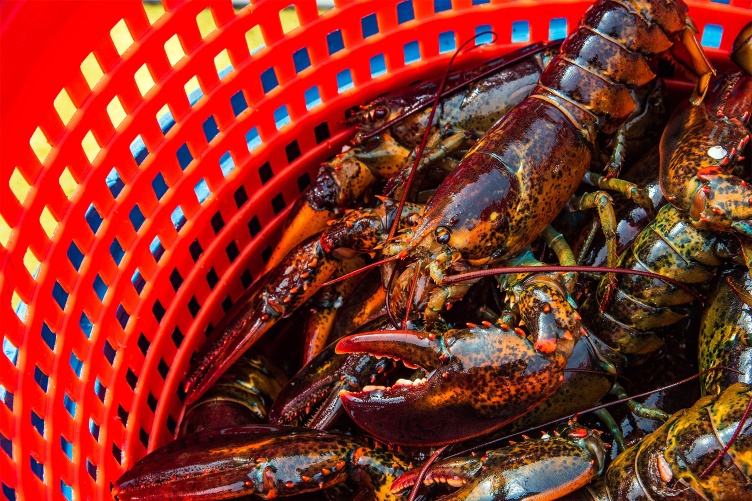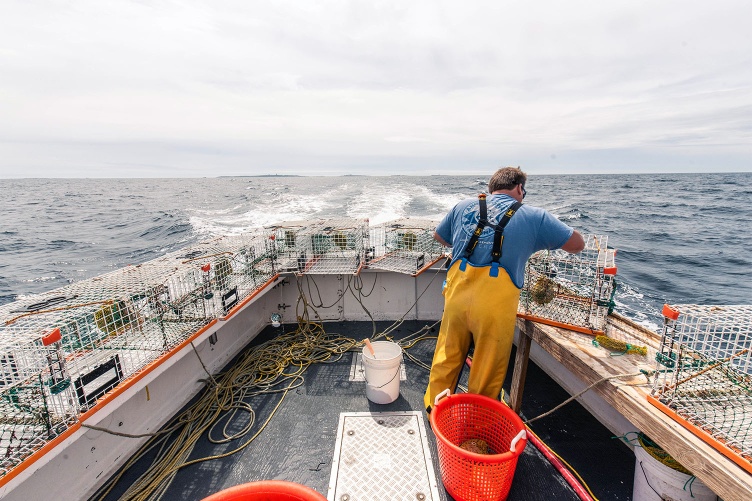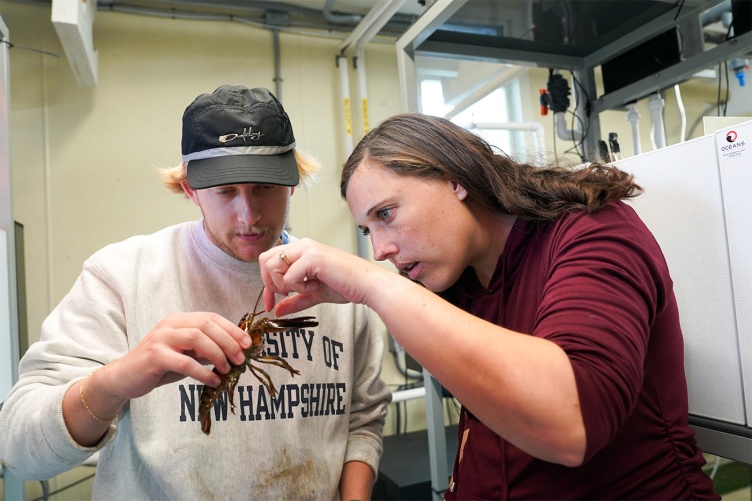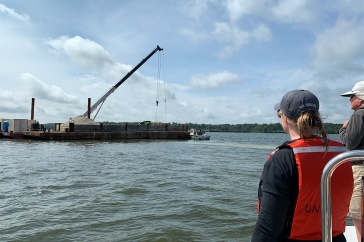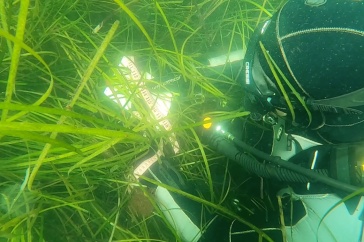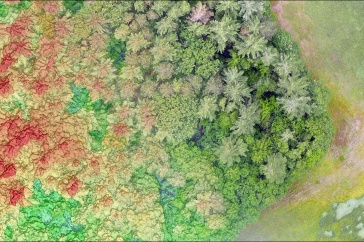Research Goal
To study the effect of ocean acidity on hunting behavior in juvenile lobster.
What is Ocean Acidification?
Ocean Acidification (OA) is the increased acidity of ocean water caused by CO2 emissions. The ocean can act as a “sponge” for CO2, but by absorbing CO2, the chemistry of the water changes and the pH level of the water decreases, which means the ocean becomes more acidic.
Ocean Acidification Effects
- Ocean Acidification is best known to corrode reefs and the shells of marine animals.
- It also seems to stimulate increased production of toxins in certain alga types, which could have negative health affects for humans who eat seafood exposed to these toxins.
Local Impacts of Ocean Acidification
- Sections of the New England coast have been previously identified as “hot spots” of ocean acidification.
What is Coastal Acidification?
Coastal acidification refers to changes in water chemistry and increased water acidity along coastlines. However, it differs from OA in that it’s caused by more by local contributors, including excess nutrient runoff from agricultural operations and fertilizers and runoff from freshwater streams and rivers. However, much like OA, coastal acidification decreases ocean pH levels and can impact shellfish, finfish and coral.
In colonial New England, the American lobster was so plentiful and cheap that it was used as garden fertilizer and fed to prisoners and servants. While no longer the case today, the crustacean remains a quintessential New England delicacy and a key economic industry for New Hampshire, making up close to 70 percent of the state’s annual commercial fisheries catch and more than $32.5 million of landed value in 2022 according to NOAA Fisheries. Officials project that New Hampshire’s lobster fishery contributes $132 million toward the state economy, which is why the recent lack of juvenile lobsters is of great concern, not just for New Hampshire’s lobster fishery but for the much larger lobster fisheries in Maine and Massachusetts as well.
Brittany Jellison, an assistant professor in the department of biological sciences in the UNH College of Life Sciences and Agriculture, is seeking to understand how these changes could impact sea life. And she’s beginning by examining how climate change-driven effects on our oceans could be causing behavioral changes in juvenile lobsters. Along with higher water temperatures, another threat to ocean life is ocean acidification, or an increase in the acidity of ocean waters that is driven primarily by ocean waters absorbing carbon dioxide from the atmosphere, causing a change in the water chemistry.
"We’re trying to determine how some of our iconic marine species may respond to changing ocean waters and, just as importantly, what that may mean for some of our fisheries,” said Jellison. “Will the behavior of the American lobster be altered in a more acidic future ocean?”
Ocean Acidification Impacts on Marine Life
Previous research has shown that increased ocean acidity can directly alter the physiology of many marine species. For example, it can decrease reproduction, growth rates and calcification–the process of shell hardening—in shelled invertebrates like crustaceans and mollusks. And recent data from the National Oceanic and Atmosphere Administration notes that surface ocean waters have already dropped 0.1 pH units in the past two centuries, representing approximately a 30 percent increase in seawater acidity.
“Our research is a step toward understanding and mitigating these changes, but the bigger picture is clear: We need to address the root causes of ocean acidification to preserve New England's cherished ocean wildlife, its fisheries legacy and its burgeoning fisheries.” ~ Brittany Jellison, assistant professor of Biological Sciences
Jellison and graduate student Todd Stelling are using a new experimental system at UNH’s Coastal Marine Lab (CML) that enables them to manipulate the chemistry of incoming ocean water. They then can determine how ocean acidification might affect lobster behavior in response to cues, like the presence of prey.
“Ultimately, we expect mortality levels to increase as pH decreases, but we’re also hoping to study the behavioral effects of the increased water acidity on the lobsters—namely whether they can find their prey as quickly,” explained Stelling, a student in COLSA’s marine biology program. “If the lobsters cannot locate their prey in a timely manner, it means longer time spent foraging, which leaves them vulnerable to predators. And decreased lobster survival rates will damage the coastal ecosystem and diminish a key fishery for New Hampshire and Maine.”
Left/top: Following their study on predator behavior, Jellison and Stelling will examine if a higher ocean acidity affects prey behavior in response to chemical cues from predatory black sea bass. Right/bottom: The new multi-stressor environment system at the UNH Coastal Marine Lab, seen here from the back. Photo credit: Alex Hatch
Jellison and Stelling will monitor and record lobster behavior in response to the presence of prey, such as blue mussels. Initially, they’ll study how pH levels affect the behavior of juvenile lobsters as a predator to identify the larger potential impact of OA on the lobster food web. The next phase of this project will examine how pH affects predator avoidance behavior in juvenile lobsters by studying lobster responses to chemical cues from black sea bass — a species that’s been pushed northward into lobster territory due to rising ocean temperatures, making it a novel predator to lobsters.
The newly constructed tank system at the CML allows researchers to create highly customized aquatic environments through automation. Each of the 20 tanks can have different temperatures and pH levels set, allowing for the testing of multiple variables at once.
“Right now, the system is being used for lobsters and behavior, but there really is no limit to the studies that can be done using it,” said Stelling. “There can be multi-stressor studies looking at ocean acidification and warming at the same time in any number of species—crabs, mussels, oysters, phytoplankton, etc.”
In the future, Jellison intends to utilize the new system to generate and control multi-stressor environments. By altering factors like the pH and temperature of ocean water, she aims to investigate how combined stressors such as ocean acidification and rising temperatures might interact to affect marine animal behavior. This will allow her and her team to further study how climate change will affect New Hampshire and Maine’s coastal environment and New England fisheries and predict models for the potential cascading ecosystem impacts of ocean acidification–and how the state’s lobster fishery can prepare for these changes.
“Over time, we may see a drastically different marine environment, where lobsters and other marine species struggle to survive in more acidic waters,” said Jellison. “Our research is a step toward understanding and mitigating these changes, but the bigger picture is clear: we need to address the root causes of ocean acidification to preserve New England's cherished ocean wildlife, its fisheries legacy and its burgeoning fisheries.”
-
Written By:
Maeve Gifford | UNH College of Life Sciences and Agriculture | Maeve.Gifford@unh.edu



















































